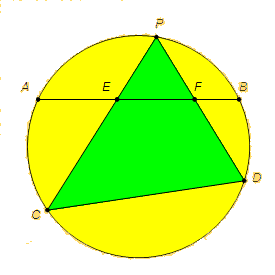|
|
||||||||||||||||||||
|
|
|||||||||||||||||||||
Donate to support this site...
Haruki's Lemma
This truly beautiful lemma is due
to Hiroshi Haruki. It leads to the
easiest proof of the
Butterfly and
Two Butterflies Theorems. You can see the proof on a great website
of
Alexander Bogomolny.
Lemma ( Haruki ) Given two nonintersecting chords AB and CD in a circle and a variable point P on the arc AB remote from points C and D, define points E and F as intersections of chords PC and AB, PD and AB respectively. Then, the value of the fraction AE · BF / EF does not depend on the position of a point P.

This problem came about when I was
giving geometry lectures to students at the TTST 2006 (Transcarpathian
Team Selection Test) for the Ukrainian Math Olympiad. The first proof of
Haruki's Lemma that I've found was full of horrible trigonometry. For
the second proof I have decided to try out my skills in the application
of complex numbers to geometry. This proof was REALLY LONG !!! However,
it gave me an idea of what to go for and the third proof, that was based
on Hiroshi Haruki's original proof of the lemma, was short and, what's
more important, fully synthetic - no ugly Trig or long complex
numbers!!!
Feeling confident, I've decided to study the situation with
the help of trilinear coordinates, leading to the fourth proof. However,
using trilinear coordinates was not the end of the story. However, at
the request of the Editor-in-Chief, I had to redo the whole thing by
using the barycentric coordinates. Well, you can
see what this led to if you check out
my article over at
Forum
Geometricorum.
One of my results states that the ratio AE · BF / EF actually equals ... *drum roll* ... hover your mouse here to find out. Isn't that sweet? What's even more sweet is the fact that this equality holds even when chords AB and CD are intersecting and point P is an arbitrary point on the circle distinct from A and B !!!
Well, if you are interested, just read my article: "Haruki's Lemma and a Related Locus Problem".
It turns out that the results
described in that article can be extended to conics, and you can read
about it here:
"Haruki's Lemma for Conics".
I hope there are still more interesting results that use
Haruki's Lemma.

Home
About me
Math
Interests
RPG
My Resume
Friends United
Contact me
Sitemap
© 2007 Yaroslav (Slava) Bezverkhnyev, a.k.a.
Agarwaen
Last Update:
April 7, 2008


